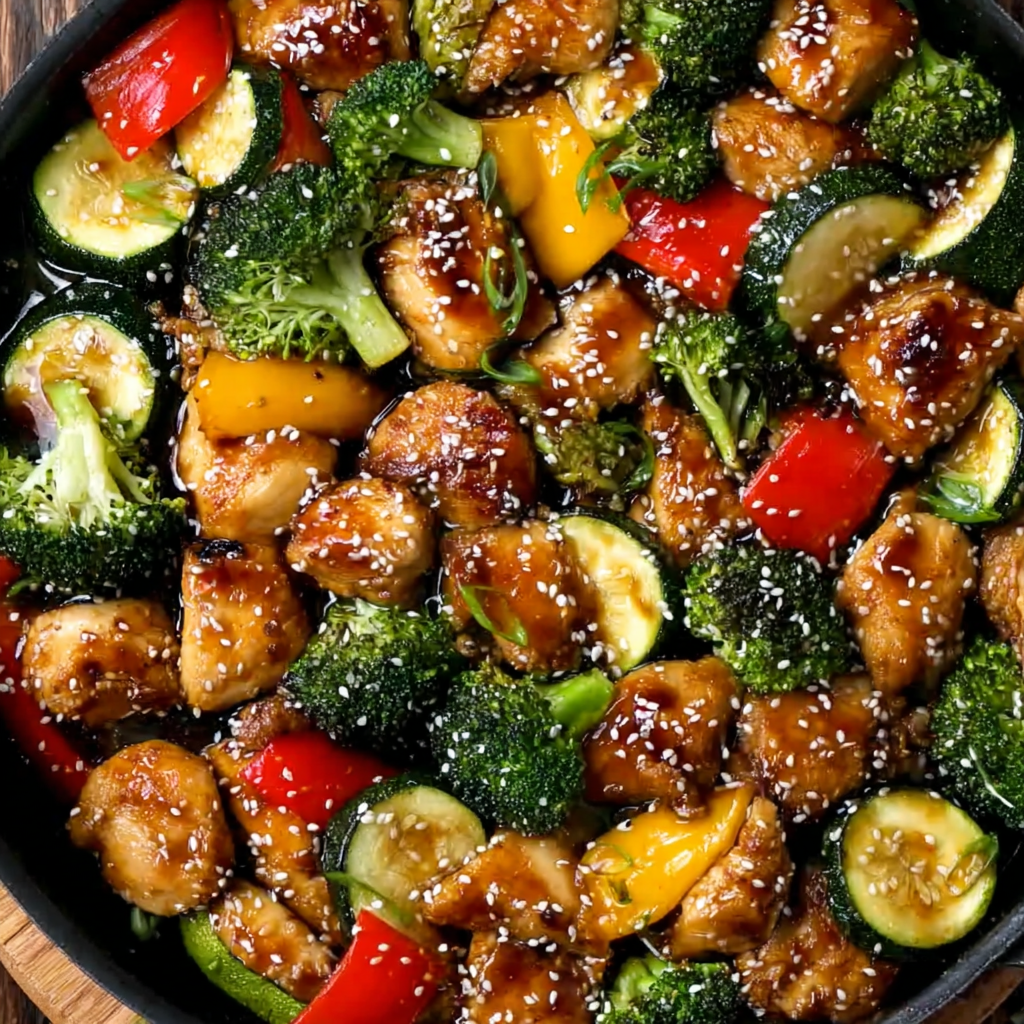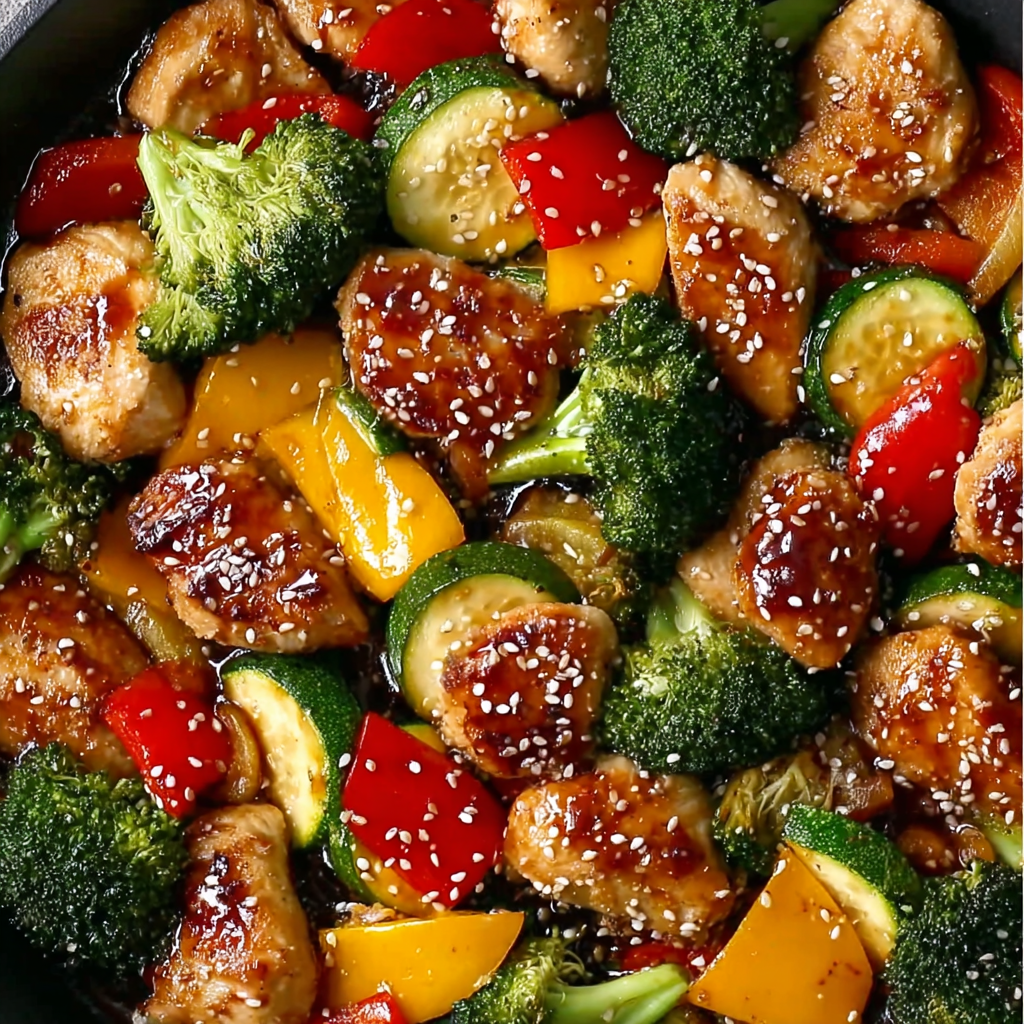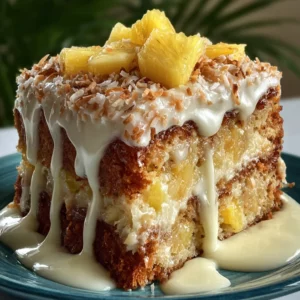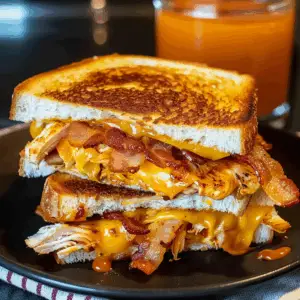What This Recipe Delivers
This teriyaki chicken sheet pan dinner is the ultimate solution for busy weeknights—a flavorful one-pan meal that combines juicy chicken, roasted vegetables, and a glossy, homemade teriyaki sauce. Everything cooks together, so cleanup is minimal and the process is streamlined for speed.
The sauce takes inspiration from the classic teriyaki cooking style, balancing sweet, savory, and tangy flavors without using wine. With a quick marinade and oven roasting at high heat, you get deep caramelization, tender chicken, and crisp-tender vegetables in under an hour.
Perfect for meal prep or last-minute dinners, this recipe pairs beautifully with rice, quinoa, or even cauliflower rice. For more inspiration on sheet pan dinners, you can explore these creative Pinterest sheet pan recipes that make cooking for a crowd effortless.

Why You’ll Love It
Choose this teriyaki chicken sheet pan dinner for busy weeknights: fast, flavorful, and crispy-tender with minimal cleanup and maximum meal prep payoff.
The glossy, balanced sauce—built on umami-rich soy—mirrors tradition without wine; learn the roots of teriyaki and why soy sauce delivers dependable savory depth.
High-heat roasting on a rimmed pan encourages browning; understand the Maillard reaction and choose the right baking sheet for truly one-pan convenience and restaurant-style caramelization.
At-a-Glance (Time, Yield, Diet Notes, Tools)
Fast one-pan dinner: 15 minutes prep, 25 minutes bake; serves 4–5; dairy-free, gluten-free with tamari.
Flavor anchors: low-sodium soy, rice vinegar for brightness, and a hint of pineapple.
Tools: rimmed half-sheet, parchment, saucepan, brush, thermometer; finish with toasted sesame oil and serve over rice. Optional convection reduces time slightly, too.
Ingredient Spotlight: Teriyaki Sauce (No Wine)
A glossy, no-wine teriyaki sauce anchors this one-pan dinner with balanced sweet, savory, and tangy notes. Low-sodium soy sauce or tamari brings umami, while brown sugar and honey (or maple) add sheen. Rice vinegar and optional pineapple juice brighten; fresh garlic and ginger deliver aromatic heat; a touch of toasted sesame oil gives nutty depth. Finish with a cornstarch slurry for a clingy, restaurant-style coating that won’t turn gloopy.
For flavor balance, aim roughly three parts soy to two parts sweetener, then adjust acidity to taste. Browse glossy ideas in teriyaki inspiration boards and see how roasted veg colors pop in sheet-pan roasted vegetables. Keep heat gentle when thickening so starch activates without breaking, and whisk constantly to maintain a smooth, silky texture.
Quick tips for consistent teriyaki results:
-
Use tamari for gluten-free and slightly richer body.
-
Swap arrowroot for cornstarch if avoiding corn; simmer briefly to keep the glaze clear.
-
Double the sauce and stash for meal prep; it’s ideal for rice and veggie meal prep bowls and speedy stir-fries. Finish with lime to balance sweetness. Taste and adjust.
Ingredient Spotlight: Chicken & Vegetables
Choose boneless, skinless chicken thighs for juicy results; breasts work, but thighs resist drying during high-heat roasting. Cut into 1½-inch pieces for even cooking and sauce coverage. Build a balanced vegetable mix that can handle 425°F: broccoli florets, bell peppers, red onion, snap peas or green beans, thin carrots, and quick-cooking zucchini. Toss with neutral oil, kosher salt, and black pepper so edges caramelize while interiors stay tender-crisp.
Sturdier veg like carrots and broccoli thrive on the edges, where heat promotes browning via the Maillard reaction. Faster-cooking pieces—zucchini, snap peas, bell pepper—sit closer to the chicken to baste in juices and teriyaki glaze. Keep pieces similar in size; thin carrots on the bias cook evenly, and small florets prevent steaming. If using chicken breasts, trim thicker portions or butterfly to match the 1½-inch target for consistent doneness.
Flavor notes to match teriyaki: a drizzle of sesame oil adds nuttiness without smoking, while a splash of rice vinegar really brightens sweetness from honey, brown sugar, and pineapple juice. Season lightly upfront; the soy sauce base delivers salt. For extra color, add mushrooms or asparagus in spring, sweet potato in fall, and keep everything dry before oiling so surfaces sear, not steam.
Equipment & Sheet Pan Setup
Use a rimmed half-sheet pan for one-pan efficiency. Line with parchment or foil and lightly oil to reduce sticking.
A sturdy baking sheet resists warping at 425°F and promotes air circulation around chicken and vegetables. Avoid overcrowding; if needed, split across two pans to keep edges crisp.
Preheat the pan for faster sear and browning via the Maillard reaction. Keep a saucepan, brush, and thermometer ready for glazing and 165°F.
Step-by-Step: How to Make It
Preheat to 425°F and line a rimmed sheet pan with parchment or foil, then lightly oil. Whisk the teriyaki sauce (soy sauce or tamari, brown sugar, honey or maple, rice vinegar, optional pineapple juice, garlic, ginger, sesame oil, pepper, flakes). Reserve ⅓ cup for glazing. Toss chicken with remaining sauce and marinate 15–30 minutes in the fridge while you chop vegetables and set out tools.
Coat broccoli, bell peppers, red onion, snap peas or green beans, carrots, and zucchini with neutral oil, kosher salt, and black pepper. Spread vegetables on the baking sheet in a single layer, placing firmer pieces toward the edges for higher heat. Nestle marinated chicken on top in an even layer and discard any leftover raw marinade in the bowl. Bring the reserved sauce to a simmer; whisk in the cornstarch slurry and cook 1–2 minutes until glossy.
Bake 15 minutes, then brush or drizzle half the thickened sauce over chicken and vegetables. Continue baking 8–12 minutes, until the chicken reaches 165°F and vegetables are crisp-tender; broil 1–2 minutes for caramelized edges that showcase the Maillard reaction. Rest 5 minutes, toss with remaining glaze, taste, and adjust with a splash of soy sauce or rice vinegar for balance.
Serve over steamed rice or cauliflower rice and finish with green onions, toasted sesame seeds, and lime wedges. For best texture, avoid overcrowding by using two pans if needed, rotate halfway, and pat chicken dry before marinating. If sauce tastes too sweet, balance with vinegar or lime; if too salty, add a splash of pineapple juice or water and simmer briefly to mellow. Broil with the pan on the top rack, watching closely to prevent burning at all.

Visual Doneness Cues
Chicken at 165°F, opaque throughout; juices run clear. Vegetables browned at edges, tender-crisp centers. Sauce glossy and clinging, not watery; glaze caramelized after broil, with fragrant garlic and ginger aromas.
Variations & Dietary Swaps
Tailor this sheet pan teriyaki to your diet and pantry without losing weeknight speed. For gluten-free, choose tamari and confirm labels on vinegar and cornstarch. For low-sodium, use low-sodium soy or tamari, then brighten with acid and herbs instead of extra salt. For low-carb, reduce sugars, sweeten with allulose or monk fruit, and serve with cauliflower rice.
For a paleo-friendly feel, swap coconut aminos for soy, thicken with arrowroot, and keep the sauce to a brief simmer to preserve clarity. Map your flavors against the history of teriyaki and use toasted sesame oil as a finishing drizzle, not a high-heat sautéeing fat, to avoid bitterness and smoke.
Vegetarian swap: firm tofu (pressed and cubed) or tempeh; roast until edges crisp, then glaze. Build protein with shelled edamame. For a different glaze profile, try orange juice for the optional fruit note, or study how umami from soy sauce balances sweetness when you reduce sugars.
Seasonal variations: spring asparagus and radishes; summer zucchini and corn; fall sweet potato and mushrooms; winter broccoli and cauliflower. Spice options: red pepper flakes, gochugaru, or chili crisp. Garnish with green onions, nori strips, or lime for brightness. Sesame seeds add crunch and a nutty finish too.
Make-Ahead, Storage, Reheating & Freezer
Make the sauce 3–4 days ahead and store chilled; whisk before using. Chop vegetables up to 24 hours in advance and keep dry in sealed containers. Marinate chicken 15–30 minutes day-of; longer marinades aren’t necessary with small pieces and can oversalt. Keep an extra portion of thickened glaze for fast finishing after roasting. Keep rice separate to prevent sauce soaking and grains turning mushy.
For storage, portion chicken and vegetables with rice or cauliflower rice into airtight meal-prep containers. Cool quickly, then refrigerate 3–4 days. See practical portioning ideas in meal prep bowls to keep textures separated and garnishes—green onions, sesame seeds, lime—packed on the side until serving.
Reheat gently: oven at 350°F for 8–12 minutes, or a skillet with a splash of water to re-steam glaze; microwaves work in short bursts. For freezer meals, cool completely, glaze, then freeze up to two months; thaw overnight and rewarm. Browse batch-cook sheet pan dinners on Pinterest for labeling and rotation tips.
Meal-Prep Plan
Portion the roasted chicken and vegetables into four or five containers with rice or cauliflower rice. Aim for balanced macros: roughly half vegetables, a quarter protein, a quarter carbs, plus a small portion of sauce.
Cool quickly before lidding to avoid condensation. Add garnishes—green onions, sesame seeds, lime—right before eating. See visual ideas in meal prep bowls for compartment layouts that keep crisp textures and prevent soggy vegetables.
For variety through the week, rotate sauces—reserve extra teriyaki or add a chili-garlic drizzle—and pair with simple sides like cucumbers or edamame. Browse sheet pan dinners on Pinterest to plan flavor profiles.
Serving Suggestions & Pairings
Serve over jasmine rice, brown rice, quinoa, or cauliflower rice to suit your goals. Garnish generously with green onions, toasted sesame seeds, and lime wedges for a bright, restaurant-style finish at home.
Add freshness with quick cucumber salad splashed with rice vinegar, or pair with miso soup and steamed edamame. A touch of sesame oil on the finished bowl boosts aroma without overpowering delicate vegetables.
Keep the teriyaki vibe classic—see teriyaki—with nori strips and pickled ginger for salty, crunchy contrast.
Troubleshooting
Soggy vegetables come from crowding and moisture. Dry everything, oil, and spread in a layer; use two pans if needed. Preheating the pan helps water evaporate fast so edges crisp instead of steam.
Pale chicken? Pat dry before marinating and finish under the broiler to harness the Maillard reaction. For underseasoned results, season vegetables with salt, then finish with a splash of soy sauce to avoid oversalting.
Watery glaze? Simmer the reserved sauce first, then add slurry and cook. If it tastes salty, add rice vinegar or pineapple juice; if sweet, add vinegar and a pinch of salt to rebalance.

FAQs
Can I use chicken breasts instead of thighs? Yes; cut to 1½-inch pieces and check early to avoid overcooking. How long should I marinate? Fifteen to thirty minutes is enough for small pieces. What vegetables work best? Broccoli, peppers, onions, carrots, snap peas, and zucchini roast evenly at 425°F without turning mushy.
Can I use frozen vegetables? Yes, but do not thaw; roast from frozen and expect extra moisture—give them space on the baking sheet. How do I thicken without cornstarch? Use arrowroot, simmer briefly, and avoid boiling hard to keep a clear glaze, then finish with toasted sesame oil.
How do I make it gluten-free? Use tamari and confirm labels on rice vinegar. Is pineapple juice necessary? No; orange juice works, or simply increase honey slightly. What temperature and time? Roast at 425°F for 23–27 minutes total, broiling briefly for caramelization driven by the Maillard reaction.
How do I prevent soggy vegetables? Dry, avoid crowding, and use two pans. Can I make the sauce ahead? Yes, 3–4 days refrigerated. Can I double the recipe? Yes; use two pans and rotate. How do I reheat leftovers? Oven at 350°F or skillet with a splash of water.
Is this recipe dairy-free? Yes. Can I grill or air-fry? Grill over medium-high, glaze at the end; air-fry at 380–400°F in batches, shaking for even browning. What should I serve with it? Rice, quinoa, cucumber salad, miso soup, or steamed edamame and lime wedges.
PrintTeriyaki Chicken Sheet Pan Dinner for Busy Weeknights
Turn weeknights into wins with this teriyaki chicken sheet pan dinner: juicy chicken, roasted vegetables, and a glossy, no-wine teriyaki sauce that cooks entirely on one pan. A quick marinade, high-heat roasting, and a fast cornstarch glaze deliver restaurant-style caramelization with minimal cleanup. Flexible veggies, gluten-free friendly with tamari, and perfect for meal prep—serve over rice or cauliflower rice, finish with green onions and sesame, and dinner’s done.
- Author: Clara
Ingredients
For the teriyaki sauce (no wine):
- ⅓ cup low-sodium soy sauce (or tamari for gluten-free)
- 3 tbsp brown sugar
- 2 tbsp honey or maple syrup
- 2 tbsp rice vinegar
- ¼ cup pineapple juice (optional, for natural sweetness)
- 3 cloves garlic, minced
- 1 tbsp fresh ginger, grated
- 1 tbsp toasted sesame oil
- ¼ tsp black pepper
- Pinch red pepper flakes (optional)
- 2 tsp cornstarch + 2 tbsp cold water (slurry for thickening)
For the chicken and vegetables:
- 1½ lb boneless, skinless chicken thighs, cut into 1½-inch pieces (or use breasts)
- 3 cups broccoli florets
- 2 bell peppers, sliced
- 1 small red onion, cut into wedges
- 1 cup snap peas or green beans
- 2 medium carrots, thinly sliced on the bias
- 1 medium zucchini, sliced into half-moons
- 2 tbsp neutral oil (avocado or canola)
- Kosher salt and black pepper, to taste
For serving:
- Sliced green onions
- Toasted sesame seeds
- Steamed rice or cauliflower rice
- Lime wedges (optional)
Instructions
- Preheat oven to 425°F (220°C). Line a rimmed sheet pan with parchment or foil and lightly oil it.
- Whisk soy sauce, brown sugar, honey, rice vinegar, pineapple juice (if using), garlic, ginger, sesame oil, black pepper, and red pepper flakes. Reserve ⅓ cup for glazing. Toss the chicken with the remaining sauce and marinate 15–30 minutes in the fridge.
- Toss broccoli, bell peppers, red onion, snap peas, carrots, and zucchini with the neutral oil, a pinch of salt, and black pepper.
- Spread the vegetables on the sheet pan. Nestle the marinated chicken pieces on top in a single layer. Discard any leftover chicken marinade in the bowl.
- Bring the reserved ⅓ cup sauce to a simmer in a small saucepan over medium heat. Stir in the cornstarch slurry and cook, stirring, until glossy and slightly thickened, 1–2 minutes. Remove from heat.
- Bake the sheet pan for 15 minutes. Brush or drizzle half of the thickened teriyaki over the chicken and veggies. Continue baking 8–12 minutes, until the chicken reaches 165°F (74°C) and vegetables are crisp-tender. Broil 1–2 minutes at the end for caramelized edges, if desired.
- Rest 5 minutes, then toss on the pan with the remaining teriyaki to coat. Taste and adjust with a splash of soy sauce or rice vinegar if needed.
- Garnish with green onions and sesame seeds and serve over rice.
Notes
-
Use chicken thighs for forgiveness; breasts work with careful timing.
-
Cut chicken to 1½-inch pieces to match vegetable cook times.
-
Place firm veg on pan edges; nestle faster veg near the chicken.
-
Reserve ⅓ cup sauce for glazing; simmer and thicken before brushing.
-
Broil briefly for caramelized edges; watch closely to avoid burning.
-
Balance flavors at the end: add soy sauce for salt or rice vinegar for brightness.
-
For gluten-free, use tamari and verify labels on vinegar and starch.
-
Double the recipe on two pans; rotate halfway for even browning.




